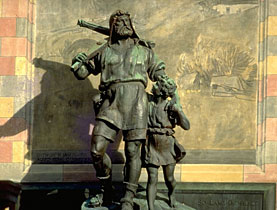William Tell: killer or freedom fighter?

Legendary Swiss marksman William Tell is often portrayed as a heroic freedom fighter. But when he killed the Habsburg bailiff, was it not the act of a murderer?
In a new exhibition the Neuchâtel Art and History Museum takes a provocative look at Switzerland’s mythical hero throughout the ages. State archives also reveal the western canton’s early interest in Tell.
William Tell, a simple peasant from canton Uri, has been reinvented many times over the centuries: saint, legendary figure, mythical being, an apostle of freedom, but at other times a political murderer.
“Tell is an extremely malleable character; he’s ambiguous with all kinds of different faces,” curator Jean-Daniel Morerod, a professor of medieval history at Neuchâtel University, told swissinfo.ch.
Inside the exhibition a larger-than-life statue of the marksman dressed in a yellow-blue-and-red-striped mercenary uniform dating from 1585 prepares to shoot a bolt.
The huge wooden figure used to stand at the entrance of Bern’s arsenal to impress visitors.
“The authorities were proud of the threat that Tell represented at the end of the 16th century,” said Morerod.
Among the various paintings and sketches on show, a young Tell from the Romantic period stands looking pensive in frilly white shirt and green breeches with a sword in his belt – a sort of Swiss Hamlet.
This is in stark contrast to Richard Kissling’s huge statue of the muscular peasant lovingly resting his powerful hands on his son’s shoulders, which was erected in Altdorf in 1895.
Early legends
The earliest reference to William Tell appeared in the “White Book of Sarnen”, a chronology of events transcribed at the start of 1470s.
This was closely followed by the Tellenlied, a song composed in 1477, presenting the apple shooting and Tell’s escape but not the assassination of Habsburg bailiff Gessler.
Later chronicles mentioning Tell include those of Melchior Russ (1480) and Petermann Etterlin (1507), as well as a play, Tellspiel, first performed in Altstadt in 1512.
“What is striking is how very quickly – roughly 50 years – Tell goes from an unfamiliar figure to a famous one known to all Swiss,” said Morerod.
The emergence of the printing press helped spread his story. Parents retold it to their children and it was performed on stage or sung, especially in military circles.
Create solidarity
Later Aegidus Tschudi’s “Chronicon Helveticum” (1550) gave a fuller account, making Tell a protagonist of a major episode in the country’s history.
The exhibition has a French translation of the Tellspiel and a drawing of the archer dating from 1560-70, recently found in Neuchâtel’s cantonal archives, suggesting an early interest in the Uri peasant.
“Even if he is a maverick and a complicated personality, Tell belongs to the legendary founding myths of Switzerland, which are based on unity, oath and harmony,” Morerod said.
Such stories emerged during a period of profound upheaval in the mid-15th century following the wars of Zurich and Burgundy, when there was a need to create a sense of community and solidarity within the Confederation to prevent it from breaking up.
Delicate death
But Gessler’s death was a delicate issue for the authorities. At the end of the 16th century several incidents of social unrest in central Switzerland were inspired by Tell’s story. In 1653 a group of three peasants known as the “Three Tells” ambushed Lucerne officials, killing a parliamentarian.
The idea of the emergence of new political assassins haunted the aristocracy.
To minimise the threat some versions of Tell’s story saw him associated and eventually merged with the three Rütli Oath founding fathers. In one he became the son-in-law of one of the trio, Walter Fürst.
Much more emphasis was also put on the apple-shooting part of the story and Tell’s devotion as a father to distract from the bloodshed.
In the eighteenth century interest in Tell reached new heights.
“New Gesslers”
After describing Bern aristocrats as “new Gesslers” poet and activist Samuel Henzi was beheaded in 1749.
Brothers Gottlieb Emanuel and Albert von Haller caused a scandal in 1760 by challenging the Swiss belief that Tell was theirs and theirs alone in their pamphlet “William Tell, A Danish Fable”.
Plots against the French monarchy and Jacobin assemblies were likened to the secret pact signed on the Rütli. The Tell tyrannicide was also used to justify the guillotining of Louis XVI.
Throughout the 19th century and up to the Second World War, Tell was seen as a symbol of rebellion against tyranny both in Switzerland and abroad.
Foreign role model
In 1766 French writer Antoine-Marin Lemierre wrote a play inspired by Tell, with the image of a hero freeing his people from the yoke of monarchy.
The Swiss hero crossed the Atlantic where the concept of the warrior fighting for national independence found favour in the colonies during the American Revolution of 1776.
After 1798 Tell became the symbol of the Helvetic Republic, the new French-run Confederation, representing the purity of the revolution over the despotism of aristocracy.
He got a new lease of life in 1804 when Friedrich Schiller wrote the play Wilhelm Tell. Gioachino Rossini followed with his 1829 opera of the same name.
Elsewhere Russian revolutionaries drew inspiration from Tell and Adolf Hitler was a fan of Schiller’s play and the united people ideals embodied in the work. But after several assassination attempts, the play was banned in Germany in 1941.
In 1969 Palestinian extremists fired on an Israeli passenger jet at Zurich airport, claiming they were acting in the spirit of the Swiss archer.
Modern hero?
Today Tell lives on as a hero in popular culture.
According to a 2004 survey, 60 per cent of the Swiss believe that he existed, although most historians generally regard the saga to be a fiction, since neither Tell’s nor Gessler’s existence can be proven.
Morerod said Tell’s future prospects were rosy, particularly abroad. A 3D Hollywood film on the Swiss action hero is due for release in 2012, and a US TV mini-series is still in the pipeline.
“And over the past couple of years there has been a renewed thirst for liberty; we should market William Tell to the Arab world,” he said.
The legend says Tell came from the village of Bürglen in canton Uri. He was a hunter, a family man and skilled with a crossbow. On November 18, 1307 he is said to have travelled a few kilometres from Bürglen to Altdorf, Uri’s main town.
As he walked through the town square, he chose to ignore the hat of Gessler, which the Habsburg bailiff had placed on a pole. Gessler demanded that everyone who passed should bow before it. Failure to do so was tantamount to treason.
Tell was arrested for his snub and Gessler threatened to execute him unless he could prove his skill as a marksman. The bailiff had an apple placed on the head of Tell’s son, Walter, and ordered the archer to shoot it off.
If he missed, both were to die. Tell shot and the crossbow bolt split the apple. Tell confessed that he had hidden a second arrow on his body, which he would have used on Gessler in case of injury to his son. The bailiff was enraged and refused to free Tell. Instead, the archer was placed in irons and put on a boat for Küssnacht where he was to be jailed.
A sudden storm blew up threatening to capsize the small craft. Tell’s captors released him, realising that he alone could steer the boat to shore because of his knowledge of the lake.
Tell brought the boat close to some rocks and, leapt to safety. He eventually made his way overland to Küssnacht to seek revenge. He ambushed Gessler’s party on its way along a main road through the forest, shooting the tyrant through the heart with his last arrow.
The Swiss hero then vanished from the scene of the crime and nothing more is heard of him.
There is no mention of Tell either in the state archives in Vienna of the former Habsburg empire, or in historical documents preserved in canton Uri. Historians have trawled through medieval registers and have come up empty handed.

In compliance with the JTI standards
More: SWI swissinfo.ch certified by the Journalism Trust Initiative















You can find an overview of ongoing debates with our journalists here . Please join us!
If you want to start a conversation about a topic raised in this article or want to report factual errors, email us at english@swissinfo.ch.